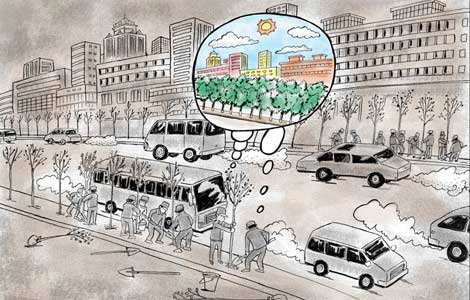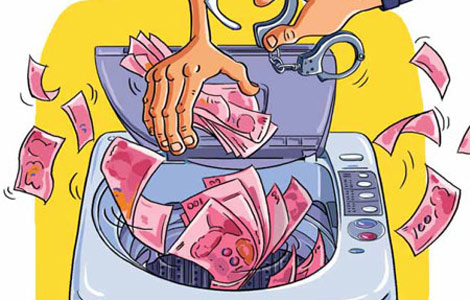Portland shares green approach with Kunming
Updated: 2014-01-25 03:12
By HU YONGQI in Kunming (China Daily)
|
|||||||||||
Planning and design experts from Portland, the United States, are helping Kunming to promote walking and cycling to lower carbon emissions and alleviate traffic congestion.
A contingent from the Oregon city recently made a four-day visit to the capital of Yunnan province.
It was part of the US-China EcoPartnership agreement signed in May 2012.
The pact between the US city and Kunming focuses on bicycling systems, low-carbon development, ecological protection and tourism around Dianchi Lake, as well as transit development in the city.
The partnership originated from the US-China Framework for 10-Year Cooperation on Energy and Environment signed in 2008.
In October, Portland Mayor Charlie Hales met with Kumming Mayor Li Wenrong to discuss such low-carbon measures as trails for bikes and bike-sharing near subway stations. In the most recent meeting, the Portland delegation and project managers and Kunming’s top urban planning and design authorities aimed to reach a consensus on the new policy.
Denver Igarta, planner for the Portland Bureau of Transportation, said experts from his city visited a trail for bicycles along the Panlong River and surrounding areas of Dianchi Lake.
“The guiding principles that we borrowed from Europe—safety, comfort, attractiveness, connectedness and directness — mean walking and cycling must be within a short distance, and safety should be ensured,” he said.
He called for a complete network for bicycles and pedestrians and urged experiments to find new ways to handle the two groups.
“We’ll see how the practices in Portland fit the context of Kunming and modify drivers’ behavior and habits to ensure safety,” Igarta said.
Figuring out how to cross streets safely has been a headache for many pedestrians and cyclists in Kunming.
The Portland experts’ suggestions included setting up yellow flashing lights and buttons for pedestrians’ use.
Kunming and Portland are different in size, and the experts suggested that Kunming do multiple implementation simultaneously.
“Even in the US, traffic behaviors are different from one city to the next. Portland also has some very crazy drivers. The connotation of design must be relevant to the context,” Igarta said. “We need to enforce the law and encourage people to do things in the legal way, not violate the traffic rules.”
Portland has very dense street grids with many small blocks in its downtown areas. To curb congestion, the city’s core area has a signal system that controls vehicle speed, according to Michael Armstrong, deputy director of the Portland Bureau of Planning and Sustainability.
Armstrong said fewer people are driving there, and the number of cyclists has risen.
Kunming already has started to set aside more paths along roadways for walking or cycling.
Noting that Kunming is smaller and less densely populated than Portland, Armstrong said the Chinese city should invest more in infrastructure to make cycling easier — especially at rush hour.
“Congestion makes it harder for everyone,” he said. “If private cars are less desirable, people will shift to other modes of transportation, such as walking or bicycling.”
Kunming is now building six subways connecting its downtown with the suburbs. Beijing also has been promoting bike-sharing near subway stations, but that initiative has largely failed due to the inconvenience of having to return the bikes.
Portland has been running its light rail for 30 years and allows bikes to be taken onto the trains. Igarta suggested Kunming emulate this practice and the bike-share system that Portland will start to operate later this year.
“People can swipe a card to rent a bike outside subway stations and ride to their destination. However, the key is how to park the bikes when the users arrive,” he said.
Regarding the struggle of China’s transportation system to keep pace with the country’s urban expansion, Armstrong said Portland created an urban growth boundary, leaving enough space for population and job growth in the past 30 years.
Li Yingqing and Guo Anfei contributed to this story.
Related Stories
Blazers complete season sweep of Bulls in fine style 2013-03-23 10:36
Portland coach fined $35,000 for comments about officiating 2011-04-19 13:17
Air pollution chokes as smog migrates 2014-01-23 13:24
Guangzhou to limit vehicles on smoggy days 2014-01-22 15:06
Today's Top News
8.8% salary hikes expected for 2014
China turns the tables on gamblers
China takes measures against H7N9
Terrorists behind twin explosions in Xinjiang
2014 diplomatic strategy outlined at Davos
China reports another H10N8 case
Big events in the Sino-French relations
IMF chief warns of risks to recovery
Hot Topics
Lunar probe , China growth forecasts, Emission rules get tougher, China seen through 'colored lens', International board,
Editor's Picks

|

|

|

|

|

|





